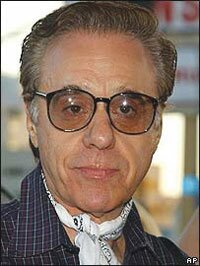FILM- Tour de Bogdanovich: Director says films 'have gone to hell'

Peter Bogdanovich: "It always bothered me that people would think of me as a writer first because I never was."
PUBLICITY PHOTO
"The level of film culture in this country has gone to a new low," says director Peter Bogdanovich. "It has kind of gone to hell. All movies tend to look the same because they're all made the same way."
Too much footage gets shot, he contends.
"Then," says Bogdanovich, "the decisions are made in the cutting room which lead to scenes that don't seem to have a conception before they're shot. Hardly any shot goes on for more than a few seconds.
"It's awfully easy to make films that way," he says, "What used to be the ‘B'-pictures of old are now the ‘A'-pictures, and the ‘A'-pictures don't get made."
Having made what some consider masterpieces, Bogdanovich seems to have a right to complain.
His first three hits, The Last Picture Show (1971), What's Up, Doc? (1972), and Paper Moon (1974), received 11 Academy Award nominations between them. He discovered Jeff Bridges, Cybill Shepherd, and Sandra Bullock, and directed legends like Audrey Hepburn and Boris Karloff in farewell performances. Quentin Tarantino ranked Bogdanovich's They All Laughed (1983) among his 10 favorites. ("He knows every line in the picture," Bogdanovich says.)
Now 71, Bogdanovich began his film career as a critic and obsessive moviegoer, and he interviewed countless major Golden Age directors from Howard (His Girl Friday) Hawks to Fritz (Metropolis) Lang for magazines like Esquire. Some consider him the first American to cerebrally interview Alfred Hitchcock.
These oral histories formed books that place him among America's foremost film scholars, along with his 1993 book, This is Orson Welles.
While Bogdanovich is a consummate director, his recurring role as therapist Eliot Kupferberg on The Sopranos returned him to his roots as an actor and reconfigured his public persona.
"Most of the time people thought of me as a writer who became a director or a writer who became an actor," says Bogdanovich. "And it was just the opposite: I was an actor who became a director who became a writer."
Bogdanovich's best role, in his opinion, is in The Other Side of the Wind–- a long-awaited unfinished Orson Welles film whose release has been delayed for decades by legal entanglements.
"We're right in the midst of final negotiations for the rights with Showtime," Bogdanovich says. "It looks good—that's all I can say at the moment."
(He describes Welles' footage as "wonderful stuff" and enthuses that director John Huston's starring role is "so unbuttoned it's scary.")
Bogdanovich wrote, directed, and acted in his first film, Targets (1968). Loosely based on sniper Charles Whitman's Texas rampage, this prescient movie's homicidal gunman seems painfully current. "I wish the picture was dated," Bogdanovich sighs, "but it isn't."
His next three films, beginning with The Last Picture Show, skyrocketed; and his sudden stardom shocked him.
"I think you can cuddle up with failure and just say, ‘I'm misunderstood' and all that," he explains. "But success, you don't know what to do with it, because people behave differently toward you and you don't understand why."
He admits to making artistic mistakes that he might have avoided had he had "just had a couple more failures." But his sorrows climaxed in 1980 with something completely out of his control: the murder of his then-girlfriend, Dorothy Stratten. The tragedy has occasionally overshadowed his work, but as Bogdanovich recovered, he says a literary genius helped him heal.
"I didn't think I'd ever direct again," he remembers. But he says that reading great literature, particularly The White Goddess by Robert Graves, "got to me and helped me get through that period."
Though his career has been mercurial, Bogdanovich survived to challenge expectations including his 2007 documentary, Runnin' Down a Dream, celebrating the 30th anniversary of Tom Petty and the Heartbreakers. A mutual friend suggested him to Petty, who admired Bogdanovich's work. Yet Bogdanovich was unfamiliar with Petty.
"The idea of doing a rock documentary was such an interesting challenge mainly because I didn't know how the hell to do it," he says. "I'm often challenged by the unknown; how to do it is often an inspiration to me."
After hearing the music, Bogdanovich met with Petty: "I said, ‘Tell me the story of the band,' and he told it to me. And I said, ‘Well, that's the movie— you telling it.' I think it's as good a piece of work as I've done."
Though he's now an elder statesman of the movies, with legions of acolytes, Bogdanovich says he really believes that a decadence pervades most American films.
"We're just decadent, period. There's just not very much happening. I lamented that to Orson in the '70s, and he said, ‘Well, what do you want? The Renaissance only lasted 60 years.'"
~
The Film Festival will feature a retrospective of Bogdanovich's films and he will introduce Paper Moon at noon on Friday, November 5, at the Culbreth Theatre and The Last Picture Show at 1:30pm Saturday, November 6, also at Culbreth. The Cat's Meow starring Kirsten Dunst and Eddie Izzard plays Thursday, November 4, at 5:45pm at the Regal 4, and What's Up, Doc? screens at 10:45am Sunday, November 7, at the Paramount Theater.
#